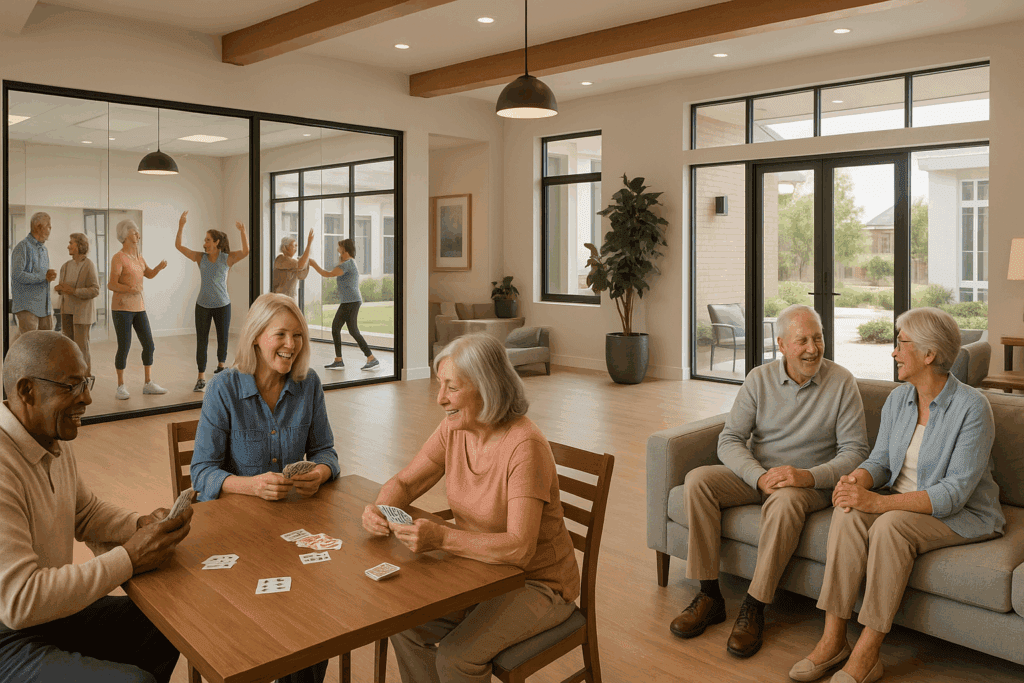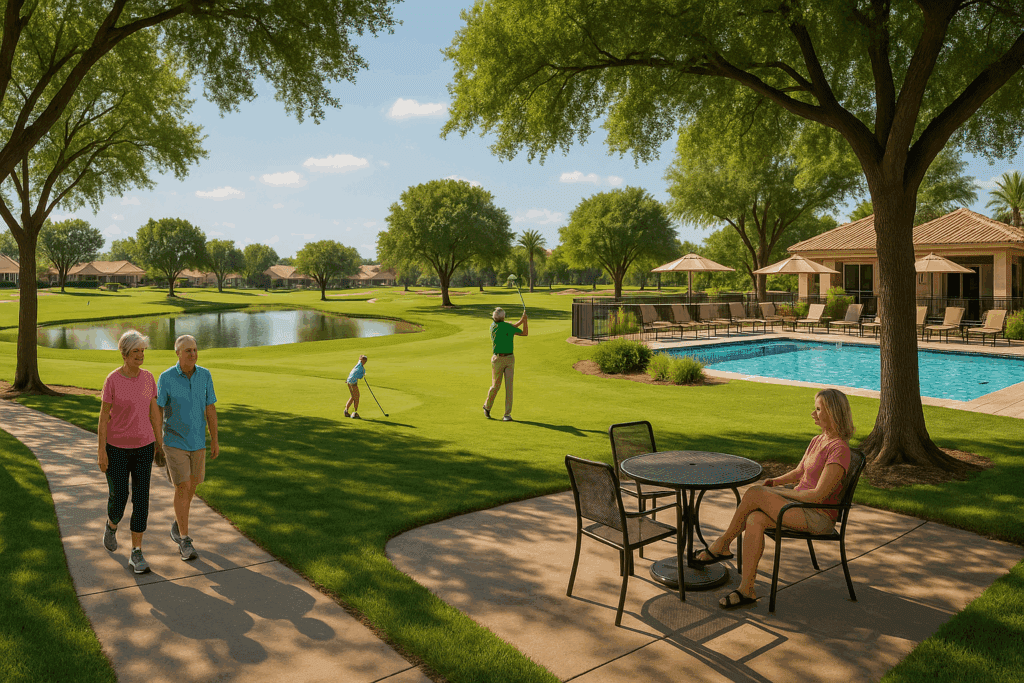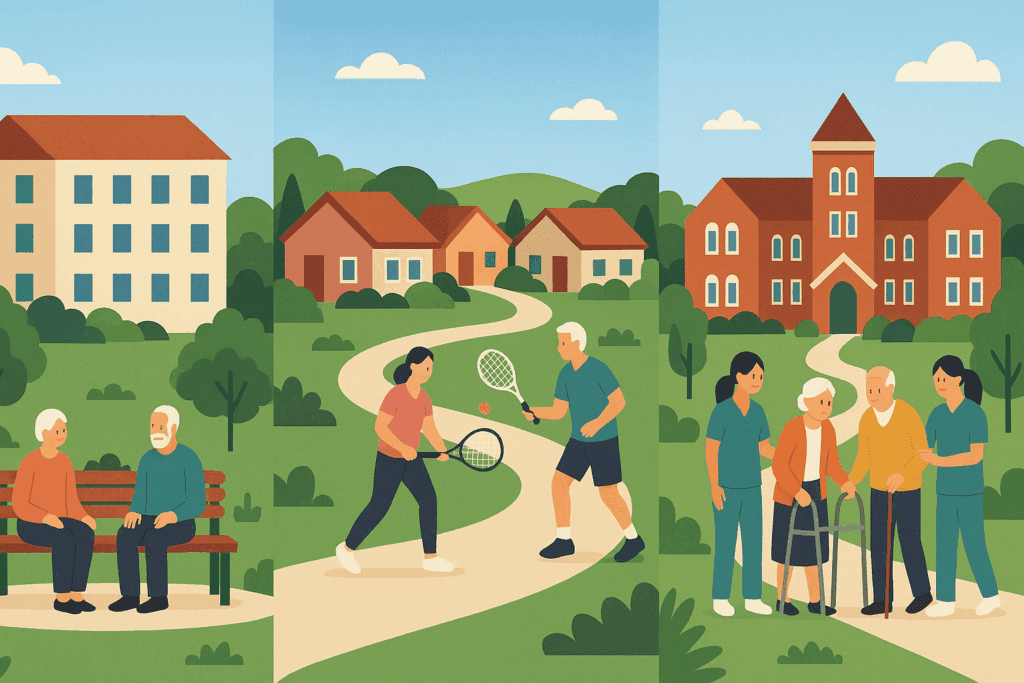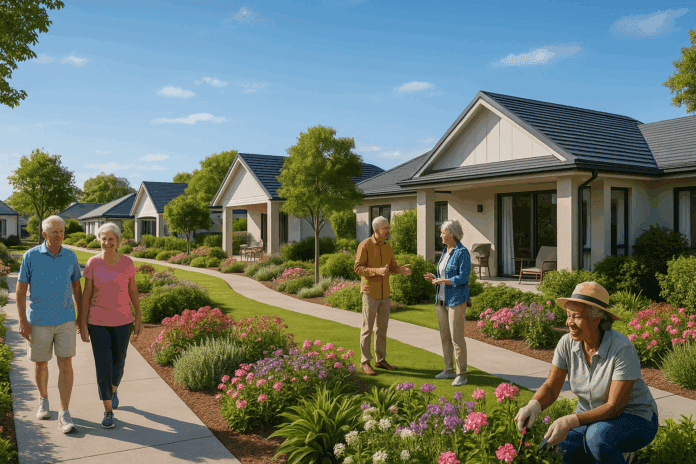Retirement is a stage of life that many look forward to with a mixture of excitement and apprehension. For those considering transitioning to a 55 and older community, the decision is both significant and life-changing. Searching for “55 and older communities near me” often marks the beginning of a journey toward a lifestyle that balances independence with community support. In this comprehensive guide, we will explore everything you need to know about finding the right 55 and older community, including expert tips on what to consider, how to evaluate your options, and ways to make the transition as smooth as possible.
You may also like: The Ultimate Retirement Ideas: Transforming Your Golden Years into a Fulfilling Journey

Understanding 55 and Older Communities
55 and older communities, also known as active adult communities, are residential areas designed specifically for individuals aged 55 and up. These communities cater to the lifestyle needs of older adults, offering amenities and social opportunities that promote both independence and a sense of belonging. Understanding what these communities offer, and how they differ from traditional neighborhoods or assisted living facilities, is crucial for making an informed decision.
The primary appeal of 55 and older housing is the lifestyle it promotes. Many of these communities provide maintenance-free living, meaning that residents don’t have to worry about yard work, home repairs, or other upkeep tasks that can become burdensome with age. Instead, residents are free to engage in social activities, pursue hobbies, and enjoy the benefits of a community that shares common interests and life experiences.

Key Features of 55 and Older Communities
When searching for “55 and older communities near me,” it’s important to understand the key features that define these communities. Most 55 and older communities offer amenities such as:
- Clubhouses and recreational facilities for social gatherings
- Fitness centers and swimming pools to promote physical health
- Walking trails, golf courses, and outdoor spaces for leisure
- Planned activities and clubs for residents to connect and engage
- Security and maintenance services for a safe and hassle-free living experience
These features are designed to enhance the quality of life for residents, making it easier to stay active, social, and connected. The focus on community living also means that many residents form lasting friendships and enjoy a strong sense of community spirit.

Types of 55 and Older Communities
Not all 55 and older communities are the same. Understanding the different types available can help you make an informed choice. Some common types include:
- Independent Living Communities: Designed for older adults who are fully independent but want to enjoy the benefits of community living without the hassles of home maintenance.
- Active Adult Communities: These are typically larger communities with a range of amenities and activities, focused on promoting an active lifestyle.
- Continuing Care Retirement Communities (CCRCs): These offer a continuum of care, including independent living, assisted living, and nursing home care, allowing residents to stay in the same community as their needs change.
- Leased Communities vs. Owned Homes: Some communities offer leased properties, while others allow residents to purchase their homes. Each option has its own set of financial implications and lifestyle considerations.
Understanding these differences can help you narrow down your search when looking for “55 and older communities near me.” Each type of community offers unique advantages depending on your lifestyle preferences and long-term plans.

Finding 55 and Older Communities Near Me
The search for the right community begins with exploring local options. A simple online search for “55 and older communities near me” can provide a list of communities in your area. However, visiting these communities in person is crucial. Virtual tours can only show so much; experiencing the community firsthand allows you to get a feel for the environment, meet current residents, and see the amenities up close.
When visiting, pay attention to the community layout, cleanliness, and the friendliness of residents and staff. Ask questions about community events, security measures, and maintenance services. Also, inquire about the average age of residents and the overall vibe of the community—some are more active and social, while others are quieter and more private.
In the next sections, we will explore financial considerations, tips for evaluating communities, and steps to make the transition smooth and enjoyable.
Financial Considerations When Choosing 55 and Older Housing
One of the most important aspects of finding the right “55 and older communities near me” is understanding the financial commitment involved. Costs can vary widely depending on the type of community, location, and the range of amenities offered. Typically, 55 and older housing options include monthly fees for maintenance, security, and access to facilities such as clubhouses, fitness centers, and community events.
When evaluating the costs of 55 and older communities, it is crucial to consider the following:
- Homeownership vs. Leasing: Some communities allow you to purchase a property, while others operate on a rental basis. Homeownership often includes property taxes, homeowners association (HOA) fees, and maintenance costs, while leasing may offer a more predictable monthly payment.
- HOA Fees: These fees cover the cost of maintaining community amenities, landscaping, security, and sometimes even utility services. It is important to understand what is included in these fees to budget accordingly.
- Entrance Fees: Some communities, particularly Continuing Care Retirement Communities (CCRCs), require an upfront entrance fee. This fee can be substantial but often includes guaranteed care as your needs evolve.
- Cost of Living Adjustments: Be aware that monthly fees may increase over time to reflect changes in the cost of living or improvements in community services.
Understanding these financial elements ensures that you can comfortably afford the lifestyle without unexpected surprises.

Evaluating 55 and Older Communities Near Me
When exploring “55 and older communities near me,” it’s important to have a clear set of criteria to evaluate each option. Here are some practical tips for making an informed choice:
- Visit Multiple Communities: The only way to truly understand what a community offers is to visit it in person. Take note of the cleanliness, friendliness of the staff, and the overall vibe.
- Talk to Current Residents: Residents are the best source of information about daily life in the community. Ask them about the activities, management, and overall satisfaction.
- Review the Community Rules: Every community has its own set of guidelines regarding pets, parking, guest policies, and home modifications. Make sure these rules align with your lifestyle.
- Assess Healthcare Proximity: Proximity to hospitals and medical facilities is crucial, especially as health needs may change over time.
- Understand the Community’s Structure: Some communities are age-restricted, while others are age-targeted. Age-restricted communities legally require at least one resident to be 55 or older, while age-targeted communities cater to older adults without strict age limitations.
Making the Transition Smooth and Enjoyable
Transitioning to a 55 and older community is a significant lifestyle change. To make this process smooth and enjoyable, consider the following steps:
- Downsize with Purpose: Moving to a 55 and older community often means downsizing. Take the time to sort through your belongings, keeping only what is necessary and meaningful.
- Get Involved Early: Joining community activities right away can help you meet neighbors and feel at home faster.
- Embrace the Lifestyle: Take advantage of the amenities and planned activities. These communities are designed to promote active living and social interaction, so be open to trying new things.
- Stay Connected with Family and Friends: While it’s important to build relationships within your new community, staying connected with loved ones outside the community can help maintain a sense of balance and fulfillment.
Moving to a 55 and older community is not just about finding a new place to live; it’s about embracing a new lifestyle that encourages engagement, activity, and a strong sense of community. In the next sections, we will explore how to choose the right community for your needs and plan for the long term.

How to Choose the Right 55 and Older Community
Selecting the ideal “55 and older communities near me” is not just about finding a suitable living space; it’s about identifying a community that aligns with your lifestyle, health needs, and future goals. With so many options available, it can be overwhelming to know where to start. Fortunately, there are several key steps you can take to ensure that your choice is well-informed and satisfying.
First, determine what kind of community best fits your lifestyle. Are you looking for a bustling, active community with frequent social events and recreational activities? Or do you prefer a quieter setting that offers more privacy and fewer planned activities? Identifying your priorities early on will help you narrow down your options.
Next, research the amenities offered by various communities. Some 55 and older communities provide luxurious amenities like golf courses, fine dining, and spa services, while others focus on practical conveniences like on-site medical care, fitness centers, and community gardens. Understanding what is most important to you will make it easier to find the right match.
Additionally, consider the community’s location. Many people prefer “55 plus senior living near me” to stay close to family and friends or to remain within familiar surroundings. Others may prioritize warmer climates or proximity to nature. Make a list of your top location-based preferences and use it as a guide during your search.
Finally, do not hesitate to visit multiple communities. Virtual tours are convenient, but nothing replaces the experience of walking through the community, speaking with residents, and observing the environment firsthand. Pay attention to the cleanliness, friendliness, and general atmosphere to gauge whether it feels like a place you could call home.
Planning for the Long Term in 55 and Older Housing
Transitioning to 55 and older housing is not just a short-term move; it is an investment in your future lifestyle. Planning for the long term ensures that your choice of community remains suitable as your needs change over time. This means considering aspects like health care access, mobility, and the community’s ability to adapt to your evolving needs.
One critical element of long-term planning is understanding the healthcare options available within or near the community. Communities that are situated near medical facilities or offer on-site healthcare services provide peace of mind and accessibility. For those considering Continuing Care Retirement Communities (CCRCs), the benefit is the ability to transition from independent living to assisted living or even nursing care without leaving the community.
Mobility is another important factor. Even if you are currently in good health, it’s important to think about the future. Are the community amenities easily accessible? Are there walking paths, ramps, and elevators to accommodate those with mobility challenges? These considerations can make a significant difference as time goes on.
Lastly, investigate the community’s ability to adapt. Some communities are built with aging in place in mind, offering adaptable floor plans, safety features, and services that can be added as residents age. This kind of foresight can prevent the need for another major move later on.
In the final sections, we will explore tips for making the most of life in 55 and older communities, including how to stay socially active, maintain a healthy lifestyle, and build lasting relationships with neighbors.
Making the Most of Life in 55 and Older Communities
Living in a 55 and older community offers a unique opportunity to embrace an active and socially enriched lifestyle. With numerous amenities and planned activities, residents are encouraged to stay engaged, healthy, and connected with their neighbors. To make the most of life in “55 and older communities near me,” consider the following tips for enhancing your experience and building lasting connections.
First, take full advantage of community events and activities. Many communities offer fitness classes, hobby groups, art workshops, and social gatherings designed to bring residents together. These events are not only a great way to stay physically active but also provide opportunities to form new friendships and strengthen your sense of community.
Second, explore volunteer opportunities within the community. Many 55 and older housing options include volunteer programs where residents can contribute their skills and experiences. Volunteering is a fulfilling way to stay engaged, give back, and maintain a strong sense of purpose during retirement.
Third, prioritize your health and wellness. With access to on-site fitness centers, swimming pools, and walking trails, staying active has never been more convenient. Regular exercise not only enhances physical health but also improves mental well-being, contributing to a happier and more fulfilling lifestyle.
Lastly, get to know your neighbors. Building relationships within your community adds an extra layer of support and companionship. Join social clubs, participate in neighborhood events, and be open to making new friends. A strong social network can significantly enhance your experience in a 55 and older community.
Frequently Asked Questions – 55 and Older Communities Near Me
What Are the Benefits of Living in 55 and Older Communities?
Choosing to live in 55 and older housing offers numerous benefits that go beyond traditional living arrangements. One of the primary advantages is the sense of community fostered among residents who share similar life stages and interests. These communities are designed to support active lifestyles with amenities like fitness centers, swimming pools, and organized social events. Additionally, they often provide maintenance-free living, meaning residents don’t have to worry about yard work or home repairs, freeing up time for leisure and activities. Security features and gated access are also common, adding an extra layer of safety and peace of mind.
How Do I Find the Best 55 and Older Communities Near Me?
When searching for “55 and older communities near me,” it’s important to start with a clear understanding of your needs and preferences. Online resources, local real estate agents, and community visits are excellent ways to begin your search. Virtual tours are helpful, but nothing compares to walking the grounds, speaking with residents, and getting a feel for the environment firsthand. Consider the amenities, the general vibe of the community, and how well it matches your desired lifestyle. Also, check community reviews and talk to current residents for honest insights about daily life and overall satisfaction.
What Is the Difference Between 55 Plus Senior Living Near Me and Traditional Housing?
The key difference between “55 plus senior living near me” and traditional housing lies in community design and amenities. 55 plus communities are intentionally designed to meet the needs of older adults, offering convenient, maintenance-free living and social opportunities. Unlike traditional neighborhoods, these communities often have age restrictions, typically requiring at least one resident to be 55 or older. Amenities are focused on active living, including fitness centers, community events, and accessible facilities, which are not commonly found in regular housing developments. This makes 55 and older housing a popular choice for those seeking both independence and a strong sense of community.
Are Pets Allowed in 55 and Older Housing?
Many 55 and older housing communities are pet-friendly, although specific rules vary. Some communities may have size or breed restrictions, while others may limit the number of pets per household. It’s crucial to inquire about pet policies before making a decision, especially if you have larger pets or multiple animals. Some communities also offer pet amenities like dog parks, walking trails, and even pet grooming stations. Understanding the community’s pet policies ahead of time will help ensure it aligns with your lifestyle and your furry companions.
How Does Over 55 Housing Handle Health Care Needs?
Over 55 housing communities are typically designed for independent living, but many also offer access to health care services. Some communities partner with local medical providers for in-home visits, while others have on-site wellness centers. For those with increasing health needs, Continuing Care Retirement Communities (CCRCs) provide a seamless transition from independent living to assisted living and skilled nursing care, all within the same community. This ensures that as health needs change, residents can continue living in a familiar environment. Choosing a community that provides health care support can add an extra layer of security and peace of mind.
Can Family Members Visit 55 Senior Living Communities?
Absolutely, family members are welcome to visit 55 senior living communities, and many communities even encourage family gatherings. Some communities have guest accommodations for overnight stays and common areas for family events. It’s always wise to check with the community’s management for specific visitation policies, especially for long-term guests. During holidays and special occasions, many communities host events that allow residents to celebrate with their loved ones. This commitment to family connections helps maintain strong bonds while enjoying the benefits of senior living.
What Are the Financial Considerations for 55 and Older Housing?
The financial considerations for “55 and older housing” vary based on community type and location. Many communities require monthly fees that cover maintenance, amenities, and sometimes even utilities. There may also be entrance fees, particularly for Continuing Care Retirement Communities (CCRCs), which secure long-term care options. Homeowners Association (HOA) fees are another common expense, covering landscaping, security, and community upkeep. Before committing, it’s important to understand the full scope of costs and any potential increases over time.
How Do I Transition Smoothly to a 55 and Older Community?
Transitioning to a 55 and older community can be made smoother with thoughtful planning. Begin by downsizing gradually, sorting through belongings well before your move. Visit the community multiple times to familiarize yourself with the layout and meet your future neighbors. Engaging in community events early can help establish connections and make you feel more at home. Finally, stay open to new experiences and embrace the lifestyle that comes with community living.
Is There a Sense of Community in 55 and Older Housing?
Yes, one of the hallmarks of “55 and older housing” is the strong sense of community it fosters. With planned activities, communal spaces, and resident-driven clubs, it’s easy to meet people and build lasting friendships. Many residents share common interests, making it easier to connect and engage. Social events, like game nights, fitness classes, and volunteer opportunities, further strengthen community bonds. This sense of belonging is a major reason why many choose this lifestyle.
Can I Customize My Home in 55 Senior Living Communities?
Customization options depend largely on the specific community and its policies. Some “55 senior living communities” allow residents to make interior changes, such as painting, updating fixtures, or even remodeling kitchens and bathrooms. Others may have stricter guidelines, particularly in leased properties. It’s important to ask about customization policies during your community search. Understanding the level of flexibility available ensures that you can create a living space that truly feels like home.
Conclusion: Embrace the Next Chapter in 55 and Older Communities
Finding the right “55 and older communities near me” marks the beginning of an exciting new chapter in life. These communities offer more than just a place to live; they provide a lifestyle centered around convenience, connection, and active living. By understanding your preferences, evaluating options carefully, and embracing the community lifestyle, you can enjoy a fulfilling and enriching retirement experience. Finding the right “55 and older communities near me” marks the beginning of an exciting new chapter in life. These communities offer more than just a place to live; they provide a lifestyle centered around convenience, connection, and active living. By understanding your preferences, evaluating options carefully, and embracing the community lifestyle, you can enjoy a fulfilling and enriching retirement experience.
Whether you are seeking a bustling, activity-filled environment or a peaceful, serene setting, there is a 55 and older community designed to meet your needs. Planning for the long term, staying socially active, and maintaining your health will ensure that this new phase of life is not only enjoyable but truly rewarding. Explore your options, visit communities firsthand, and take the first step toward embracing the next chapter of your life with confidence and enthusiasm.
Further Reading:
Senior Housing Guide & Apartment Options





